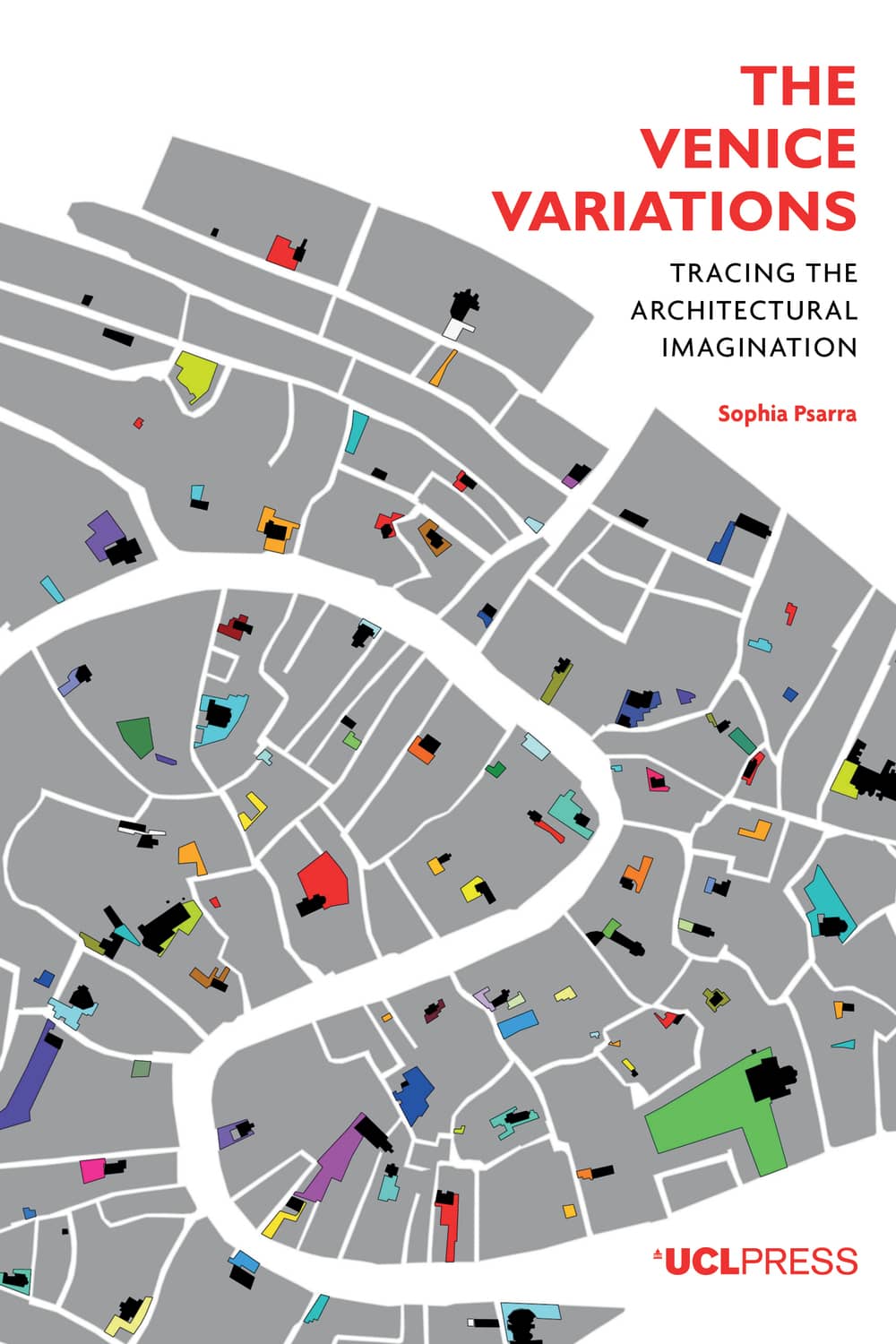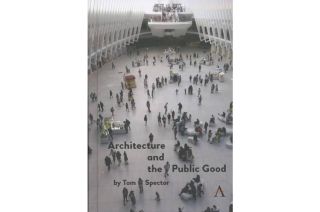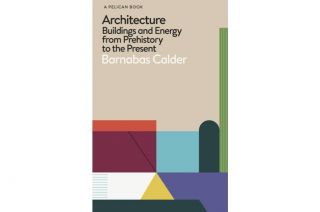
www.buildingsandcities.org/insights/reviews/venice-variations.html
The Venice Variations: Tracing the Architectural Imagination
by Sophia Psarra. UCL Press, 2018, ISBN: 9781787352391
Sherry McKay (UBC School of Architecture and Landscape) reviews this book which considers how the architectural imagination has shaped the spatial history of Venice.
 Does the
discipline of architecture possess its own form of knowledge? A possible answer
to this question is proposed through an exploration of architectural discourse
and design as it responded and responds to urban morphology. It is an answer guided
by Bill Hillier's spatial syntax analysis and Henri Lefebvre's identification
of different modes of perceptual, conceptual and lived spaces. The exchange
between these two forms of spatial understanding, one methodological the other
theoretical, is threaded through an historical account of a single city in
Sophia Psarra's The Venice Variations: Tracing
the Architectural Imagination.
Does the
discipline of architecture possess its own form of knowledge? A possible answer
to this question is proposed through an exploration of architectural discourse
and design as it responded and responds to urban morphology. It is an answer guided
by Bill Hillier's spatial syntax analysis and Henri Lefebvre's identification
of different modes of perceptual, conceptual and lived spaces. The exchange
between these two forms of spatial understanding, one methodological the other
theoretical, is threaded through an historical account of a single city in
Sophia Psarra's The Venice Variations: Tracing
the Architectural Imagination.
Space is a much-theorized topic in architectural theory, prominent within this discourse is an ambition to counter its abstraction with an understanding of space as embodied. It has produced the psychogeography of the Situationist international (1957-72), the tripartite conception of space as produced from social practice, representation and representational or symbolic means (Lefebvre, 1974) and spatial syntax analysis (Hillier and Hanson, 1984), among other propositions. Innovative images seeking to represent these alternative conceptions of space have followed. This reorientation is legible in the ambition of The Venice Variations: Tracing the Architectural Imagination to consider history spatially and is augmented by a consideration of the role of architectural imagination in the production of urban space. The book correlates macro and minor urban morphology with economic and social structures, parses the exchange between collective builders and individual architects, recounts the dialogue between imaginative interventions and existing variations of urban form, materially and representationally and charts a path between historical artefacts and contemporary conceptions of imagination and knowledge.
The architectural
imagination is a concept familiar to most design schools. It is exemplified by speculation,
invention and the transformation of precedents. Psarra casts it more
specifically as 'a conscious concern for
crafting space and using geometric
notation to establish coherence against different constraints and requirements'
(p. 225). In this manner, Psarra argues, the architectural imagination can be
expressed as principled knowledge. Psarra also proposes a second form of the imagination at
work in the devising and revising of urban morphology that is collective,
exemplified in the city anonymously crafted by customs, conventions and artisan
practices. The contrasting of architectural with collective imagination allows Psarra
to explore ways of embedding architectural practice in the social and political
practices undergirding urban morphology These two imaginations, especially its
architectural expression, are tracked through an interdisciplinary study of
Venice, drawing primarily on architectural and social histories of Venice and
space syntax analysis of urban infrastructure (canals, streets, well heads) and bodily movement.
Chapter 1 "City-craft: Assembling the city" and Chapter 2 "Statecraft: A remarkably well-ordered
society" develop the theoretical and
methodological underpinnings of the book as well as a narrative about the
social, cultural and political development of
Venice from its founding to the late 16th C. They address
the first half of the subject signaled in the title: The Venice Variations and offer a neatly bifurcated chronology that
serves to correlate urban morphology with social and political structure. "City-craft"
describes an organic city produced collectively by craft persons for a
parish-based society, while "Statecraft" delineates a hierarchical city
produced by the autonomous projects of architects for an oligarchic city
council, pre- and post-Renaissance respectively. Psarra's history of this
corelated shift is rich in description, theoretical exegesis and imagery. The
role of the imagination is insinuated into the narrative as collective
imagination of what she terms the 'unauthored' city and as architectural imagination attributed to the architect of the
'authored city'. Attention to both, unauthored and authored, she concludes, will ultimately reveal the social relevance of
the architectural project.
The following chapters,
4 "Story Craft: Calvino's Invisible
Cities" and 5 "Crafting architectural space: Le Corbusier's Hospital and
the three paradigms" shift focus from the material city of Venice to its
imaginative expression. They explore the
proposition that the complex spatial patterning created by the historical
development of Venice elicits imaginative engagement with the city in the 20th C. "Story craft" examines Calvino's literary work, Invisible Cities,
which encourages readers to imaginatively plot their own course through the
various stories that serve as representations of Venice. In also being a
collective endeavour of author and reader, this chapter mirrors the production
of the "Craft-city." "Crafting architectural space: Le Corbusier's Hospital and
the three paradigms" analyses Le Corbusier's Venice Hospital as a case study of the architectural imagination
responsive to both the city of Venice and conventions and inventions within the
architectural discipline. It mirrors "State craft". These more current case
studies interlace contemporary, architectural and aesthetic concerns with the
historical narrative of Venice's development as social, represented and
representational space.
Venice Variations does not offer an
entirely linear progression, the history explored in the first two chapters
establishes the existing morphology of the city, but little of the specific
social or political context for what is discussed in the subsequent case studies
of Invisible Cities and Le
Corbusier's Venice Hospital. The fifth chapter "The Venice Variations: Tracing
the Architectural Imagination" serves to connect the discussion of the historical
city of Venice with the larger field of the discipline of architecture, remapping
the connection between the city of Venice, Calvino's Invisible Cities and
Le Corbusier's Venice Hospital onto an expanded field of a more theoretical
understanding of the imagination, its inspiration and inventions and knowledge.
The five chapters
of Venice Variations suggest a series
of palimpsests, each successive chapter possessing an evocative impression of
what preceded it. Each chapter offers a network of ideas rather than a singular
line of development; each a web of possible readings allowing multiple
conclusions, which would seem to reflect to some extent Psarra's conception
of both Venice and a design process guided by a disciplined
imagination.
The dialogue between imagination and extant morphology is also evident in the several representations used throughout the book. The diagrams are seductive, colourful and abstract patterns, suggestive of meaning hovering over the quotidian streets, canals and piazzas of the city. While their abstraction is attractive, the meagre labelling often lessens the insight they might offer regarding the spatial practices that Psarra claims produces them. The abstraction of the diagrammatic visual aids is perhaps also calculated as a prompt for imaginative engagement, speculation on possibilities, or invitation to see Venice differently. This objective may explain the vagueness of the network diagrams or the inclusion of GIS models that do not seem to add much to the discussion otherwise.
Venice Variations: Tracing the Architectural Imagination proffers an imaginative and ambitious account of urban development
and the architect's means of engagement with it. The text is expansive, offering a virtuoso display of different
modes of knowing. But equally, the breadth of material gathered into a single
locus and the complexity of the narratives woven into each chapter and across
the book as a whole may be disorienting to some readers. The quantity of
material gathered into some 260 pages of text has meant that some concepts are given
truncated treatment and some material appears tangential. Some readers
unfamiliar with contemporary architectural discourse may find the significance
of Bill Hillier's 'generic' city (p. 59) dimmed and the criticism of digital
technologies' entanglement with neoliberalism (p. 16) blunted by a lack of
explication. Some exegesis seems to make
only an attenuated contribution to the main points of the argument. As
interesting as the discussion of the map of Manhattan is, it does not clearly
contribute to the overall thrust of the book (p. 72-75), while the brief
discussion of the 15th C portrait of Luca Pacioli over complicates
the discussion of representation (p. 135-6). The numerous spatial analyses of
modern architectural projects by different architects and for different
locations included in a chapter dedicated to Le Corbusier's Venice
Hospital seem to unnecessarily over-burden the argument.
The book is both a history and a proposed methodology, a concatenation of erudition and imagination, it is both about Venice and refers to elsewhere. It offers a rather circuitous route to making the point that the architectural imagination can access and direct toward contemporary needs and contribute to social capital. Psarra asserts that The Venice Variations: Tracing the Architectural Imagination does not offer solutions for the contemporary problems of the city or for its ongoing environmental degradation. But why doesn't this wide-ranging and theoretically rich analysis of the architectural imagination not provide insights, if not answers? What is the relevance of an architectural imagination that does not engage with such social and political concerns. The book certainly suggests why it would be important for it to do so.
Latest Peer-Reviewed Journal Content
A framework for 1.5°C-aligned GHG budgets in architecture
G Betti, I Spaar, D Bachmann, A Jerosch-Herold, E Kühner, R Yang, K Avhad & S Sinning
Net zero retrofit of the building stock [editorial]
D Godoy-Shimizu & P Steadman
Co-learning in living labs: nurturing civic agency and resilience
A Belfield
The importance of multi-roles and code-switching in living labs
H Noller & A Tarik
Researchers’ shifting roles in living labs for knowledge co-production
C-C Dobre & G Faldi
Increasing civic resilience in urban living labs: city authorities’ roles
E Alatalo, M Laine & M Kyrönviita
Co-curation as civic practice in community engagement
Z Li, M Sunikka-Blank, R Purohit & F Samuel
Preserving buildings: emission reductions from circular economy strategies in Austria
N Alaux, V Kulmer, J Vogel & A Passer
Urban living labs: relationality between institutions and local circularity
P Palo, M Adelfio, J Lundin & E Brandão
Living labs: epistemic modelling, temporariness and land value
J Clossick, T Khonsari & U Steven
Co-creating interventions to prevent mosquito-borne disease transmission in hospitals
O Sloan Wood, E Lupenza, D M Agnello, J B Knudsen, M Msellem, K L Schiøler & F Saleh
Circularity at the neighbourhood scale: co-creative living lab lessons
J Honsa, A Versele, T Van de Kerckhove & C Piccardo
Positive energy districts and energy communities: how living labs create value
E Malakhatka, O Shafqat, A Sandoff & L Thuvander
Built environment governance and professionalism: the end of laissez-faire (again)
S Foxell
Co-creating justice in housing energy transitions through energy living labs
D Ricci, C Leiwakabessy, S van Wieringen, P de Koning & T Konstantinou
HVAC characterisation of existing Canadian buildings for decarbonisation retrofit identification
J Adebisi & J J McArthur
Simulation and the building performance gap [editorial]
M Donn
Developing criteria for effective building-sector commitments in nationally determined contributions
P Graham, K McFarlane & M Taheri
Reimagining circularity: actions for optimising the use of existing buildings
R Lundgren, R Kyrö, S Toivonen & L Tähtinen
Effective interdisciplinary stakeholder engagement in net zero building design
S Vakeva-Baird, F Tahmasebi, JJ Williams & D Mumovic
Metrics for building component disassembly potential: a practical framework
H Järvelä, A Lehto, T Pirilä & M Kuittinen
The unfitness of dwellings: why spatial and conceptual boundaries matter
E Nisonen, D Milián Bernal & S Pelsmakers
Environmental variables and air quality: implications for planning and public health
H Itzhak-Ben-Shalom, T Saroglou, V Multanen, A Vanunu, A Karnieli, D Katoshevski, N Davidovitch & I A Meir
Exploring diverse drivers behind hybrid heating solutions
S Kilpeläinen, S Pelsmakers, R Castaño-Rosa & M-S Miettinen
Urban rooms and the expanded ecology of urban living labs
E Akbil & C Butterworth
Living with extreme heat: perceptions and experiences
L King & C Demski
A systemic decision-making model for energy retrofits
C Schünemann, M Dshemuchadse & S Scherbaum
Modelling site-specific outdoor temperature for buildings in urban environments
K Cebrat, J Narożny, M Baborska-Narożny & M Smektała
Understanding shading through home-use experience, measurement and modelling
M Baborska-Narożny, K Bandurski, & M Grudzińska
Building performance simulation for sensemaking in architectural pedagogy
M Bohm
Beyond the building: governance challenges in social housing retrofit
H Charles
Heat stress in social housing districts: tree cover–built form interaction
C Lopez-Ordoñez, E Garcia-Nevado, H Coch & M Morganti
An observational analysis of shade-related pedestrian activity
M Levenson, D Pearlmutter & O Aleksandrowicz
Learning to sail a building: a people-first approach to retrofit
B Bordass, R Pender, K Steele & A Graham
Market transformations: gas conversion as a blueprint for net zero retrofit
A Gillich
Resistance against zero-emission neighbourhood infrastructuring: key lessons from Norway
T Berker & R Woods
Megatrends and weak signals shaping future real estate
S Toivonen
A strategic niche management framework to scale deep energy retrofits
T H King & M Jemtrud
Generative AI: reconfiguring supervision and doctoral research
P Boyd & D Harding
Exploring interactions between shading and view using visual difference prediction
S Wasilewski & M Andersen
How urban green infrastructure contributes to carbon neutrality [briefing note]
R Hautamäki, L Kulmala, M Ariluoma & L Järvi
Implementing and operating net zero buildings in South Africa
R Terblanche, C May & J Steward
Quantifying inter-dwelling air exchanges during fan pressurisation tests
D Glew, F Thomas, D Miles-Shenton & J Parker
Western Asian and Northern African residential building stocks: archetype analysis
S Akin, A Eghbali, C Nwagwu & E Hertwich
Join Our Community

The most important part of any journal is our people – readers, authors, reviewers, editorial board members and editors. You are cordially invited to join our community by joining our mailing list. We send out occasional emails about the journal – calls for papers, special issues, events and more.
We will not share your email with third parties. Read more



Latest Commentaries
COP30 Report
Matti Kuittinen (Aalto University) reflects on his experience of attending the 2025 UN Conference of the Parties in Belém, Brazil. The roadmaps and commitments failed to deliver the objectives of the 2025 Paris Agreement. However, 2 countries - Japan and Senegal - announced they are creating roadmaps to decarbonise their buildings. An international group of government ministers put housing on the agenda - specifying the need for reduced carbon and energy use along with affordability, quality and climate resilience.
Building-Related Research: New Context, New Challenges
Raymond J. Cole (University of British Columbia) reflects on the key challenges raised in the 34 commissioned essays for Buildings & Cities 5th anniversary. Not only are key research issues identified, but the consequences of changing contexts for conducting research and tailoring its influence on society are highlighted as key areas of action.